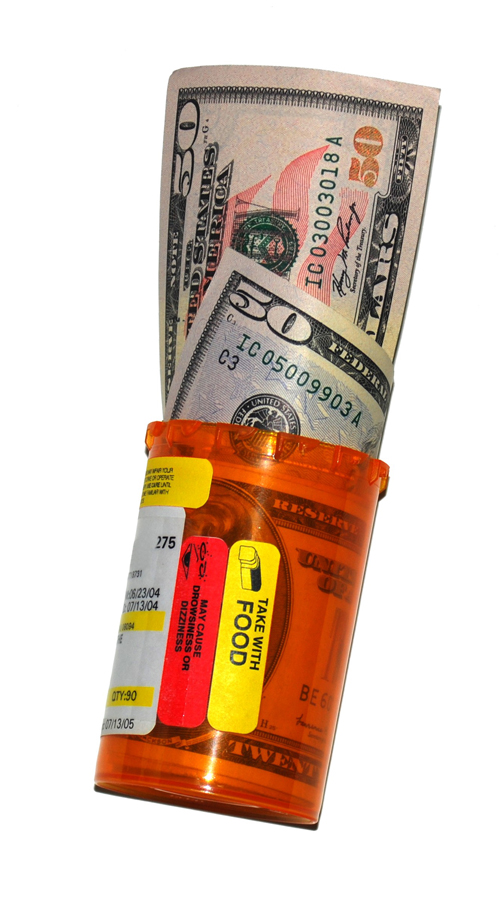Much Ado About Nothing – Most Drugs Don’t Do Anything
 A new report presented at the 105th Annual Meeting of the American Sociological Association reveals that most new pharmaceutical drugs offer practically no benefits and a whole lot of negative side effects.
A new report presented at the 105th Annual Meeting of the American Sociological Association reveals that most new pharmaceutical drugs offer practically no benefits and a whole lot of negative side effects.
Americans now spend over $200 billion a year on prescription drugs, and this spending continues to increase by an average of 12 percent each year. And drugs are now the fastest growing part of the staggeringly high American health-care bill. Yet what most people don’t know is that most drugs don’t do what they are promoted to do.
Donald Light, sociologist, professor of comparative health policy at the University of Medicine and Dentistry of New Jersey and author of the new study, explains that the drug industry as a whole produces all sorts of “lemon” drugs that do not work, whose efficacy has not been proven and whose manufacturers are protected from responsibility by industry protection laws.
“Sometimes drug companies hide or downplay information about serious side effects of new drugs and overstate the drugs’ benefits,” he said in a press release. “Then, they spend two or three times more on marketing than on research to persuade doctors to prescribe these new drugs. Doctors may get misleading information and then misinform patients about the risks of a new drug.”
According to an independent review, only about 15 percent of new drugs even work as stated, and most new drugs — whether they offer a benefit or not — come with serious side effects that are now a significant cause of death in the U.S.
The report explains that drug companies deliberately expose large amounts of people to ineffective, harmful drugs in trials, but skew them to make it look as if the drugs are effective. They then submit hosts of incomplete, inaccurate data to the FDA for approval, followed by large marketing campaigns designed to convince doctors to prescribe the newly approved drugs for both approved and unapproved uses.
According to the report, an analysis of 111 final drug applications revealed that 42 percent were missing adequate randomized trials, 40 percent had inaccurate dosage testing, 39 percent failed to show drug efficacy, and roughly half revealed the drugs to have serious adverse side effects.
Light also emphasized that, because drug companies control both the scientific testing process and the selection of which tests get submitted to the FDA or get published, the entire process is biased and flawed.
Pharmaceutical companies know that in order to make a profit, they must do one of three things: create new illnesses (such as heartburn, erectile dysfunction, social anxiety disorder, or shyness) for their new drugs to treat; get patients to ask for newer, more expensive drugs; or have doctors write more prescriptions, preferably for more expensive “me-too” drugs.
“Me-Too” Drugs
 What are “me-too” drugs? They are newer, more expensive versions of older drugs.
What are “me-too” drugs? They are newer, more expensive versions of older drugs.
Dr. Marcia Angell, former editor of The New England Journal of Medicine, discusses these “me-too” drugs in her book, The Truth About the Drug Companies. Take, for instance, the drug Nexium (perhaps you already do). Its creator, AstraZeneca, had been relying on the drug Prilosec for a significant portion of its yearly profits—$6 billion—in 2000.
However, Prilosec was going to lose its patent in 2001, and the folks at AstraZeneca were probably experiencing some heartburn at the thought. Faced with the potential for significant revenue loss, the company simply took one of the two patentable metabolites (chemicals) out of Prilosec and remarketed it as the new and improved Nexium. This “purple pill” then became the original TV drug, as we can all recall. And even though a one-month supply of Nexium costs almost nine times that of the over-the-counter version of Prilosec ($180 compared to $23), the public and their doctors have happily gone along for the ride. The truth? Studies show that both drugs work equally well at reducing stomach acid.
It is estimated that over 3 billion prescriptions were written last year. But even though the United States spends more money on health care per capita than does any other country in the world, The World Health Organization has previously ranked the U.S. health-care system first in both responsiveness and cost, but 37th in overall performance and 72nd in overall health (among 191 member nations included in the study).
More drugs don’t equal better health. Be sure to review your medications before taking them. You need to be proactive, learn what about the drugs you are taking, their potential side effects, and be sure to ask me if there are more natural options that you should consider.

Broad Review of FDA Trials Suggests Antidepressants Only Marginally Better than Placebo
A review of 4 meta-analyses of efficacy trials submitted to the US Food and Drug Administration (FDA) suggests that antidepressants are only “marginally efficacious” compared with placebo and “document profound publication bias that inflates their apparent efficacy.”
“We found that out of the 4041 patients initially started on the SSRI [selective serotonin reuptake inhibitor] citalopram in the STAR*D study, and after 4 trials, only 108 patients had a remission and did not either have a relapse and/or dropped out by the end of 12 months of continuing care,” lead study author Ed Pigott, PhD, a psychologist with NeuroAdvantage LLC in Clarksville, Maryland, told Medscape Medical News.
These means that only 2.7% of patients taking anti-depressants actually go into remission!

Sustained Benefit “Jaw Dropping”
“In other words, if you’re trying to look at sustained benefit, you’re only looking at 2.7%, which is a pretty jaw-dropping number,” added Dr. Pigott.
Overall, “the reviewed findings argue for a reappraisal of the current recommended standard of care of depression,” write the study authors.
Yep, I agree, pretty jaw dropping when you learn the potential side effects of taking a drug that may or may not be helpful.
Amino Acids and Orthomolecular Medicine
Most individuals who consult their medical doctor for mood disorders are placed on prescription medications. Many of these anti-depressants are in the form of selective serotonin re-uptake inhibitors (SSRI). These drugs (Lexapro, Prozac, Paxil, Celexa, and Zoloft) are supposed to help the brain be more efficient at using the serotonin it produces. And, as I’ve already stated, it is analogous to a gasoline additive to help your car get more mileage out of the gasoline in your tank. Unfortunately, many of these individuals don’t have any serotonin in their tanks and they are running on fumes. Since their brain isn’t making serotonin, an additive isn’t going to help.
Where do the neurotransmitters come from?
Neurotransmitters are brain chemicals that help relay electrical messages from one nerve cell to another. Neurotransmitters are produced from the amino acids in the foods we eat. Amino acids join together in different patterns to form a protein. Eating a protein-rich food allows us to replenish our ongoing demand for the essential amino acids. Half of the amino acids are essential. This means our bodies can’t manufacture them and we must get them from the foods we eat (protein). Certain amino acids, along with vitamins (B6, B3, C) and minerals (magnesium), produce the neurotransmitters. The amino acid Tryptophan turns into serotonin. The amino acid phenylalanine turns into epinephrine. Amino acids are the raw nutrients needed to manufacture the neurotransmitters which regulate our moods.
What do neurotransmitters do?
 Neurotransmitters help regulate pain, reduce anxiety, promote happiness, initiate deep sleep, boost energy, and mental clarity. The neurotransmitters that cause excitatory reactions are known as catecholamines. Catecholamines, epinephrine and norepinepherine (adrenaline) are derived from the amino acid phenylalanine. Inhibitory or relaxing neurotransmitters include serotonin and gamma-aminobutyric acid (GABA).The neurotransmitter serotonin is produced from the amino acid tryptophan. GABA is produced from the amino aid glutamine.
Neurotransmitters help regulate pain, reduce anxiety, promote happiness, initiate deep sleep, boost energy, and mental clarity. The neurotransmitters that cause excitatory reactions are known as catecholamines. Catecholamines, epinephrine and norepinepherine (adrenaline) are derived from the amino acid phenylalanine. Inhibitory or relaxing neurotransmitters include serotonin and gamma-aminobutyric acid (GABA).The neurotransmitter serotonin is produced from the amino acid tryptophan. GABA is produced from the amino aid glutamine.
Correcting the cause of mood disorders.
No one is born with a Prozac deficiency. However, people can develop a serotonin deficiency. Using a SSRI doesn’t correct the cause. If someone is out of gas (serotonin), why would you use a gasoline additive (SSRI)? Why not fill the tank (brain) up with gas (serotonin) instead? I’ve been using amino acid replacement therapy for several years and have found this approach to be far superior to using prescription medicines (in most cases) for treating mild to moderate mood disorders. I’ve treated thousands of patients with mood disorder. I’ve found very few problems with mixing amino acid therapy with prescription anti-depressants. However, you may wish to work with a health-care professional familiar with orthomolecular or amino acid therapy.
Helpful Related Links
BRAIN FUNCTION QUESTIONNAIRE The brain function questionnaire allows you to see if you’re low in certain neurotransmitters (serotoninin, norepinephrine, etc) and which amino acids you need.
–> Learn more about our all-natural mood support collection HERE
